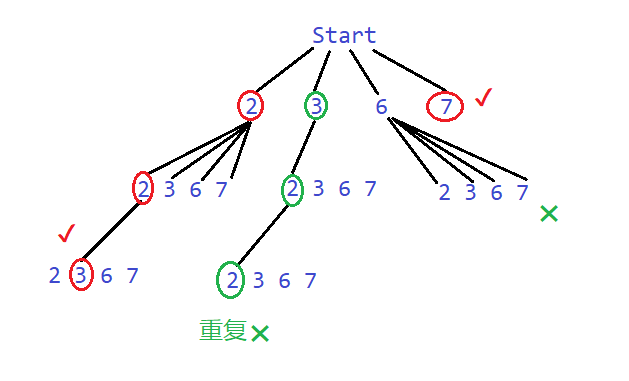给定一个无重复元素的数组 candidates 和一个目标数 target ,找出 candidates 中所有可以使数字和为 target 的组合。
candidates 中的数字可以无限制重复被选取。
说明:
- 所有数字(包括
target)都是正整数。 - 解集不能包含重复的组合
示例 1:
Input: candidates = [2,3,6,7], target = 7Output: [[2,2,3],[7]]Explanation:2 and 3 are candidates, and 2 + 2 + 3 = 7. Note that 2 can be used multiple times.7 is a candidate, and 7 = 7.These are the only two combinations.
示例 2:
Input: candidates = [2,3,5], target = 8Output: [[2,2,2,2],[2,3,3],[3,5]]
示例 3:
Input: candidates = [2], target = 1Output: []
示例 4:
Input: candidates = [1], target = 1Output: [[1]]
示例 5:
Input: candidates = [1], target = 2Output: [[1,1]]
提示:
- 1 ≤
candidates.length≤ 30 - 1 ≤
candidates[i]≤ 200 candidate中的每个元素都是独一无二的。- 1 ≤
target≤ 500
思路
本题可构建一棵树,如下图所示:
由于每次都可以出一样的数,所以我们没必要维护bool[] visited数组了。去重是一个难点,安装普通的深度优先搜索算法,能求出所以排列,但是找组合,我们需要用到STL的容器set。
我们在DFS时,传入一个set,在每次搜索到终止条件时,对当前找到的路径path进行一次排序,然后再加入到set里。set是不包含重复元素的,我们能自动完成去重任务。
最后我们再把set的内容抄到vector< vector<int> >数组里,返回出去。
初始AC代码的效率比较低的,一个原因是没有剪枝;另一个原因是我们对path反复求和,这里头包含很多重复计算。
一个改进的方法,就是把target弄成一个变化的值。在每次DFS时,只需要判断node - target是否等于0即可。改进后的AC代码效率稍微高了一点点。
代码
class Solution { // 初始AC代码, 148mspublic:vector<vector<int>> combinationSum(vector<int>& candidates, int target) {vector< vector<int> > result;if( candidates.size() == 0 ) return result;if( candidates.size() == 1 ) {if( candidates[0] > target ) return result;if( candidates[0] == target ) {result.push_back( candidates );return result;}}vector<int> path;set< vector<int> > result_set;dfs(candidates, target, result_set, path, 0);for(auto it = result_set.begin(); it != result_set.end(); it++) {result.push_back( *it );}return result;}void dfs(vector<int>& candidates,int target,set< vector<int> >& result_set,vector<int>& path,int current_sum) {// 1. Exit conditionif( current_sum >= target ) {if( current_sum == target ) {vector<int> tmp = path; // it's a mustsort(tmp.begin(), tmp.end());result_set.insert( tmp );}return;}// 2. Walk every node that not visitedfor(int i = 0; i < candidates.size(); i++) {int node = candidates[i];path.push_back( node );dfs(candidates, target, result_set, path, calculate_sum(path));path.pop_back();}}int calculate_sum(vector<int>& nums) {int sum = 0;for(int i = 0; i < nums.size(); i++) {sum += nums[i];}return sum;}};
// 改进后的AC代码,76msclass Solution {public:vector<vector<int>> combinationSum(vector<int>& candidates, int target) {vector< vector<int> > result;if( candidates.size() == 0 ) return result;if( candidates.size() == 1 ) {if( candidates[0] > target ) return result;if( candidates[0] == target ) {result.push_back( candidates );return result;}}vector<int> path;set< vector<int> > result_set;dfs(candidates, target, result_set, path);for(auto it = result_set.begin(); it != result_set.end(); it++) {result.push_back( *it );}return result;}void dfs(vector<int>& candidates,int target,set< vector<int> >& result_set,vector<int>& path) {// 1. Exit conditionif( 0 >= target ) {if( 0 == target ) {vector<int> tmp = path;sort(tmp.begin(), tmp.end());result_set.insert( tmp );}return;}// 2. Walk every node that not visitedfor(int i = 0; i < candidates.size(); i++) {int node = candidates[i];path.push_back( node );dfs(candidates, target-node, result_set, path);path.pop_back();}}};

